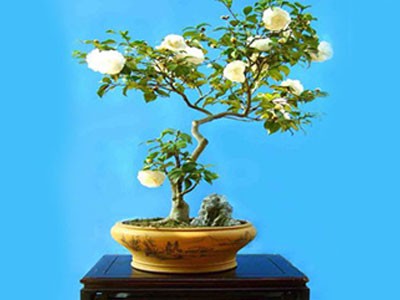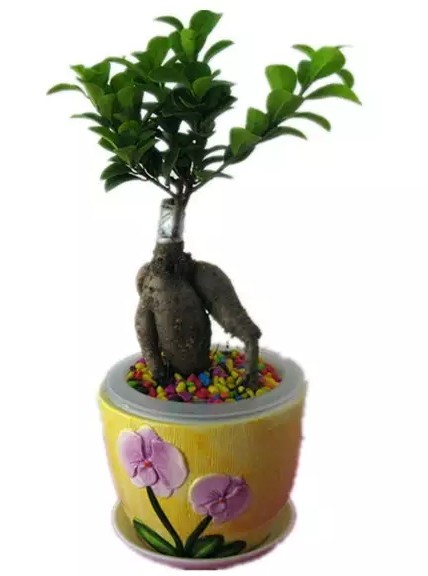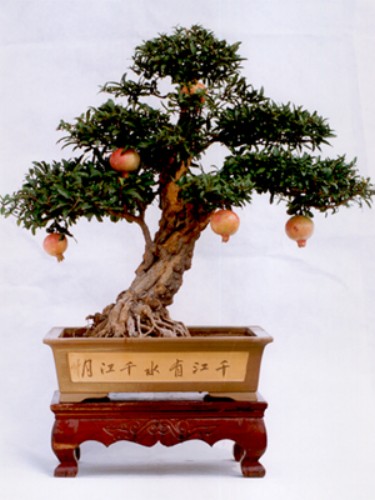Modeling method of Camellia Bonsai
Camellia belongs to the family Theaceae, which belongs to evergreen shrubs and small trees. Camellia is very popular because of its pleasant fragrance and blooming flowers, so it is often used as a bonsai plant for indoor decoration. but camellias need to be modeled before they are put indoors, how do camellia bonsai shape?

1. Select the seedlings for bonsai:
For camellias used in bonsai, seedlings should be selected in the garden with a large distance between plants. The selected plants should be camellias with shorter branches, more branches, uniform leaves, normal development and no diseases and insect pests.
2. Confirm the bonsai of camellias:
The flower bud differentiation period of camellia begins to form buds in May and June. The best pot season is in February and August of the lunar calendar in the Spring and Autumn period. At this time, the leaf buds of camellias have just germinated or not much, and the young shoots and young leaves after transplanting will not wilt and affect their growth. If you want to serve the basin in other seasons, you should keep more soil balls and move them to a cool place for a few days. Even so, it does not grow as vigorously as in February or August. For upper basin soil, mountain humus soil or hilly red sandy soil (Pinus massoniana, Camellia oleifera forest soil) should be used.
3. Determine the shape of the camellias on the pot:
The upper basin shape of camellias is generally overhanging rock type and rolling branches. The hanging rock type basin can use Yixing Gaozu dry tube basin or Gaozhuang barrel basin, and the rolling branch type basin can use proportional round basin and square basin.
4. Make clear the cultivation methods of camellias:
The camellias used for bonsai should be planted obliquely when they are placed in the pot, which is beneficial to the operation of the trunk method. Generally speaking, the body method of bending the trunk first is beneficial to the flat branches. Common body methods can be used to drop crutches and rolling dragon pole crutches. When the trunk is flat, the lateral branches, twigs and leaves of camellias should be retained. After the trunk is formed, the side branches are processed. The way of the flat branch of the lateral branch can be determined according to the format characteristics that the branch should occupy, using vertical bending, oblique bending and irregular bending respectively to fill the gap on the surface of the crown. The above flat straps are all tied with brown silk. The flat binding operation should be carried out after the new branch hardens, that is, about one month after the basin. As the wood hardness of camellias is strong, like sweet-scented osmanthus and golden marbles, we should carefully "knead the branches" in the operation of each turn, that is, each small section of the branches involved in this bend should be kneaded first, and the bark phloem of the branches will be stretched and compressed after bending in the positive and negative directions, so that the xylem can adapt to the action of external force through extrusion and stretching, so that the brown silk can be tied up. Otherwise, the branches of the plant will be broken due to the increase of sap after modeling.
5. The process of banding twigs and turning leaves:
Finally, the leaf surface of each leaf is made outward through the flat binding of the twigs. As the tree species in the shape of rolling branches are flowers and trees with flowers in their axils, the effect after modeling is that they can blossom everywhere in a spherical or Obovate plant crown to show elegance. Therefore, the process of tying twigs and turning leaves should be carried out in more detail.
PS:
With dwarf camellia old pile, usually tea plum for more, according to the bonsai modeling method, with water stone, lovely and chic. It can also be grafted with old piles, which can be quick and colorful. Mr Liu Maohua's experience is as follows:
The production of camellia bonsai depends on "artistic conception". Through human conception, camellia bonsai skillfully deals with the stem, knot and roots of natural camellia seedlings, so as to express the feeling of stretching, unrestrained and unrestrained. When making bonsai with camellia seedlings, we should choose camellia seedlings with tall and straight posture, abundant posture, complete tree shape and bending resistance of trunk branches, and basically clear layers, mainly trunk treatment, then branching, topping, and finally root exposure treatment.
The trunk is treated into curved trunk and other shapes. in the production, according to the trend of seedling materials, decisive pruning plastic arts means are adopted to deal with the branches so that the trunk leaves the main branches with foil function. Knot is the main part of dynamic performance, which should be paid special attention to.
In the process of branching treatment, we must make sure that the tree shape is symmetrical, the weight is suppressed, the length is reasonable, and the artistic means of mutual harmony, such as density, emptiness, exposure, echo, rigidity, clumsiness, thickness and so on, must be adhered to in the whole layout of tree stump bonsai.
Time: 2019-06-13 Click:
- Prev

Tree shape making and pruning method of ginseng banyan bonsai
Ginseng banyan bonsai modeling, the main effort should be used to lift the root, so that it forms the shape of hanging roots and showing claws. Of course, branches, stems and leaves can not be ignored, because they are an inseparable whole of a tree. The branches and leaves are often modeled in a hierarchical natural style. The branches of the banyan tree are soft, and the banding time is longer than the average tree.
- Next

Plastic technique of pomegranate bonsai
At present, pomegranate bonsai is popular in the flower market. Judging from the market situation, the price of pomegranate bonsai with good shape is high but sells fast. Of course, good quality comes from good cultivation techniques. Today, the editor of the World Factory Modern Agriculture Network will send you a complete collection of pomegranate bonsai cultivation techniques. For thousands of years
Related
- Fuxing push coffee new agricultural production and marketing class: lack of small-scale processing plants
- Jujube rice field leisure farm deep ploughing Yilan for five years to create a space for organic food and play
- Nongyu Farm-A trial of organic papaya for brave women with advanced technology
- Four points for attention in the prevention and control of diseases and insect pests of edible fungi
- How to add nutrient solution to Edible Fungi
- Is there any good way to control edible fungus mites?
- Open Inoculation Technology of Edible Fungi
- Is there any clever way to use fertilizer for edible fungus in winter?
- What agents are used to kill the pathogens of edible fungi in the mushroom shed?
- Rapid drying of Edible Fungi

